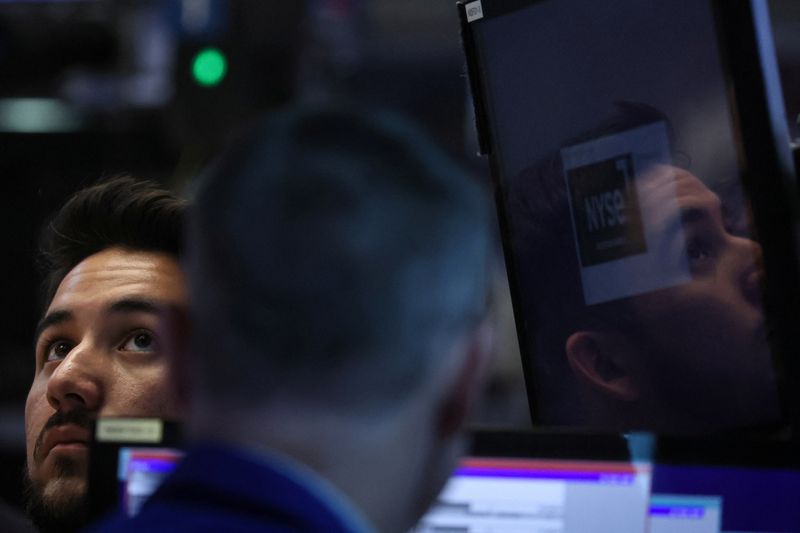Investing.com -- U.S. stock futures were broadly lower as traders awaited a batch of fresh labor market data over the final two days of the trading week. Meanwhile, attention remains focused on the bond market after a rally in sovereign debt on Wednesday provided some relief to battered stock markets, and crude prices remain on the back foot after their steepest one-day decline in over a year.
1. Futures point lower
U.S. stock futures pointed to a lower open on Wall Street on Thursday, with investors gearing up for the release of crucial labor market data.
At 05:24 ET (09:24 GMT), the Dow futures contract was 129 points or 0.4% lower, S&P 500 futures shed 18 points or 0.4%, and Nasdaq 100 futures had lost 55 points or 0.3%.
On Wednesday, the 30-stock Dow Jones Industrial Average gained 0.4%, ending a three-day losing streak, while the benchmark S&P 500 rose by 0.8% and the tech-heavy Nasdaq Composite jumped by 1.4%.
Boosting the main indices on Wall Street were numbers from payrolls processor ADP (NASDAQ:ADP) which showed that private job growth came in at 89,000 in September, far below estimates of 160,000.
The figures reignited hopes that the labor market in the world's largest economy is slowing, which could give the Federal Reserve less headroom to keep policy restrictive for a longer period of time. This prospect helped partly stem a recent sell-off in government bonds, relieving some downward pressure on equities.
2. Bond yields in focus
Traders are keeping a close eye on sovereign bonds over the final days of the trading week, particularly on whether government debt yields may flag the potential risk of an incoming recession.
The closely-watched 10-year and 30-year U.S. Treasury yields both inched higher on Thursday, in a sign that Wednesday's rally may be short-lived. At 05:24 ET, the 10-year Treasury yield had risen by 0.01 percentage points to 4.745%, while the 30-year had edged up by 0.01 percentage points to 4.886%. Yields, which typically move inversely to prices, remain near their highest levels in almost a decade.
Globally, the German 10-year Bund yield, a benchmark for eurozone bonds, also ticked up, hovering just under its highest mark since 2011.
Worries remain that the sharp recent surge in bond yields, which was sparked by a hawkish monetary policy update from the Fed last month and exacerbated by a run of stronger-than-expected U.S. economic data, may take its toll on some part of the financial system. One analyst at ING predicted to the Financial Times that "something is going to snap, but I'm not quite sure what."
3. Jobless claims ahead, NFPs loom large
Investors will have the chance to parse through weekly jobless claims on Thursday, which will serve as a prelude to the all-important September nonfarm payrolls report tomorrow.
Economists project that the latest weekly number of Americans filing for unemployment benefits is expected to have increased to 210,000 from 204,000.
Analysts at ING suggested that the "contemporaneous" nature of these figures -- as opposed to the more backward-facing job vacancies reading earlier this week -- could give a better sense of the current state of the U.S. labor market.
The Fed has made cooling worker demand a priority during its over year-long campaign of aggressive rate hikes, in the hopes that this trend would ease wage growth and help quell stubbornly elevated inflation. Signs of a persistently strong labor market could bolster the case for the central bank to maintain rates at a higher level for longer.
4. Negotiations hit snag between Kaiser Permanente, unions
Talks between Kaiser Permanente and unions representing over 75,000 striking workers stalled without a settlement just hours after the start of the largest-ever healthcare sector walkout in U.S. history.
In a statement, Kaiser said that it had reached a tentative agreement with union leaders over several unspecified issues, although the labor groups said they were still awaiting a "meaningful response" from the healthcare provider's executives.
The unions, which have been calling for better pay and increased hiring to fill what they describe as crisis-level staffing shortages, said that no further negotiations have been set.
They added that a planned three-day work stoppage that began on Wednesday is still in effect. The strike involves nurses, lab technicians, pharmacists and other support staff in five different U.S. states and Washington D.C., impacting around 13 million patients. Kaiser has said that its hospitals and emergency facilities would remain open.
5. Crude lower after steep loss on Wednesday
Oil prices erased early gains on Thursday, turning lower after tanking in the previous session as traders gauged an uncertain demand outlook following a significant build in U.S. gasoline inventories.
Crude settled more than $5 a barrel lower on Wednesday, the sharpest one-day loss in more than a year, following the release of data showing the largest weekly build in almost two years for stockpiles of U.S. gasoline, suggesting a significant dropoff in demand as the summer driving season ends.
The Organization of Petroleum Exporting Countries and allies, known as OPEC+, had reaffirmed on Wednesday that Saudi Arabia and Russia would continue to cut output by at least 1.3 million barrels a day until the end of the year.
By 05:24 ET, U.S. crude futures traded 0.8% lower at $83.53 a barrel, while the Brent contract was down 0.7% to $85.17.
